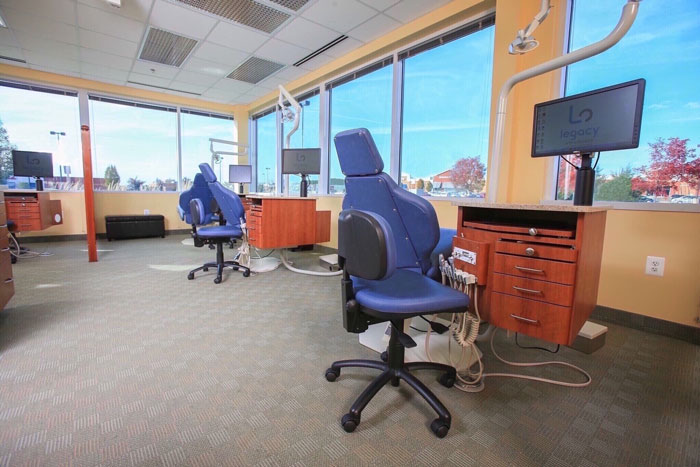The Facts About Legacy Orthodontics Uncovered
The Facts About Legacy Orthodontics Uncovered
Blog Article
The Of Legacy Orthodontics
Table of ContentsLegacy Orthodontics Can Be Fun For AnyoneLegacy Orthodontics - The Facts3 Simple Techniques For Legacy OrthodonticsLegacy Orthodontics - TruthsLegacy Orthodontics Can Be Fun For Everyone
In enhancement, we use adjustable therapy schedules, flexible payment choices and a fun, delightful experience.An orthodontist is a dentist educated to diagnose, stop, and deal with teeth and jaw irregularities. Orthodontists work with individuals of all ages, from youngsters to grownups.
Malocclusion, or misaligned teeth, can cause dental issues, including tooth degeneration, gum tissue illness, and difficult or agonizing chewing. Yet not every person is birthed with straight teeth. If you have a negative bite or big areas between your teeth, you might wish to consult a dental professional focusing on orthodontic treatment.
What Does Legacy Orthodontics Do?
( Photo Credit: DigitalVision/Getty Images) Orthodontists utilize repaired and removable oral gadgets, like dental braces, retainers, and bands, to transform the setting of teeth in your mouth. Orthodontic treatment is for dental irregularities, consisting of: Jagged teethBite troubles, like an overbite or an underbiteCrowded teeth or teeth that are as well much apartJaw misalignmentThe goal of orthodontic treatment is to enhance your bite.
A healthy and balanced bite guarantees you can consume, eat, and speak properly. While you may consider orthodontists as mostly for children or young adults who require braces, they can fix dental troubles at any age. Orthodontists participate in college, dental college, and orthodontic institution. After college graduation, they invest 2 or 3 years in an orthodontic residency program.
, but not all dental practitioners are orthodontists. They concentrate on 2 locations: Just how to appropriately and securely move teeth Exactly how to effectively assist growth in the teeth, jaw, and faceOnce an orthodontist has completed training, they have the alternative to end up being board accredited.
Legacy Orthodontics Can Be Fun For Anyone
Misalignment, or malocclusion, is one of the most typical reason people see an orthodontist. It is genetic and is the result of dimension differences in between the top and reduced jaw or in between the jaw and teeth. Malocclusion results in tooth overcrowding, an irregular jaw, or irregular bite patterns. Malocclusion is generally treated with: Your orthodontist attaches steel, ceramic, or plastic square bonds to your teeth.
If you have only small malocclusion, you might have the ability to make use of clear braces, called aligners, rather than standard braces (https://www.interweave.com/plus_old/members/legacyortho/profile/). Some people require a headwear to help relocate teeth right into line with stress from outside the mouth. After braces or aligners, you'll need to use a retainer. A retainer is a customized device that keeps your teeth in area.
They're frequently made use of on youngsters. They can develop extra space in the mouth without having to pull teeth. If you have a severe underbite or overbite, you might require orthognathic surgery (also called orthodontic surgical procedure) to extend or reduce your jaw. Orthodontists make use of Visit This Link cords, medical screws, or plates to sustain your jaw bone.
You may require to see an orthodontist if you have: Crowding or not sufficient space for all of your teethOverbite, when your top teeth come by your bottom teethUnderbite, when your bottom teeth are too much forwardSpacing or problems with gapsCrossbite, which is when your upper teeth fit behind your bottom teeth when your mouth is closedOpen bite or a vertical space in between your front base and top teethMisplaced midline, when the center of your base and upper teeth don't line up Fixing a dental malocclusion can: Make attacking, eating, and talking easierImprove the balance of our face and your total appearanceEase discomfort from temporomandibular joint conditionsDifferent your teeth and make them easier to cleanse, helping protect against dental cavity or dental caries It's typically a dental practitioner that initially notices misaligned teeth throughout a regular test.
What Does Legacy Orthodontics Mean?

Throughout your first orthodontic consultation, you'll likely have: A dental examPhotos taken of your face and smileDental X-raysPanoramic (360 degree) X-rays of your face and headImpressions to produce mold and mildews of your teethThese tests will aid your orthodontist recognize how to continue with your treatment. braces. An orthodontist is a dentist that's had training to treat your teeth and jaw
An orthodontist is focused on your bite, so something like a cracked tooth would be taken care of by a dentist. Orthodontists are focused on your bite, or the means your teeth fit together, and the straightness of your teeth.
Ever before asked yourself how celebrities always seem to have perfectly straightened teeth? The answer typically depends on the competent hands of an orthodontist. What exactly does an orthodontist do? Orthodontists are dental professionals who concentrate on fixing abnormalities in the teeth and jaws. Their experience exceeds simply producing a beautiful smile; it encompasses boosting your overall oral health and feature.
The Buzz on Legacy Orthodontics

, orthodontists have a diverse toolkit at their disposal. These reliable braces use a system of braces bonded to the teeth and linked by cords.
Clear aligners, like Invisalign, are a popular choice for individuals looking for a much more very discreet therapy option. These detachable trays are tailor-made to considerably shift the teeth's setting. Headwear might be made use of combined with braces or aligners to apply extra targeted forces, especially for fixing jaw discrepancies. In situations of narrow jaws, palatal expanders can be utilized to develop room for correct tooth alignment.
Report this page